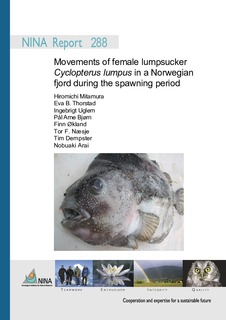| dc.description.abstract | Mitamura, H., Uglem, I., Thorstad, E.B., Bjørn, P.A., Økland, F., Næsje, T.F., Dempster, T. & Arai, N. 2007. Movements of female lumpsucker Cyclopterus lumpus in a Norwegian fjord during the spawning period. - NINA Report 288. 20 pp.
Lumpsucker are distributed throughout the North Atlantic Ocean, and migrate considerable distances between offshore feeding areas and shallow inshore spawning areas. In July 2006, a study on the movements of female lumpsucker during the spawning period was carried out in Øksfjord, Northern Norway. Twenty fish (mean body mass 3.2 kg, range 1.5- 4.8 kg) were tagged with acoustic transmitters and released in the inner part of the fjord. Their distribution was subsequently recorded by 22 automatic acoustic receivers distributed throughout the study area. All the fish migrated rapidly out of the fjord. The average time of leaving the fjord (17 km from the release site) was three days, and within one week after release all the fish had left the fjord. The fish did not return to Øksfjord within the nearly three-month study period. These results indicate that female lumpsucker stay in the fjord only for a short time during the spawning season, and that they depart the spawning ground immediately or a few days after spawning. The tagged females were likely in the beginning of the spawning period when they were tagged, based on 1) the mass/length relationship of the tagged females, 2) the fact that eggs could be seen when implanting the transmitters, and 3) because 18 out of 19 females (95%) caught at the same time and sites as the tagged fish had large egg masses. We suggest that the tagged females, when they left the study area in Øksfjord, either left inshore areas migrating back to the ocean because they had finished spawning, or that they continued the spawning, but moved to new fjord systems in search for new males. Whether individual females visit several fjords during the spawning period and search for males over a relatively large area should be addressed in future studies of this species. The female lumpsucker in this study were actively swimming, and often did so against the tidal current. There were no indications that female lumpsucker were passively drifting with the currents, or that they used the tidal current actively to move out of the fjord. The fish were, on average, moving a minimum of 0.72 km per hour relative to the ground during the study. Such extensive movements might make these females highly vulnerable to exploitation by passive gears used in the commercial fishery. During the outward migration, 75 % of the fish were recorded close to salmon farms. However, the tagged fish left the fjord without staying for extended periods around the fish farms (the longest stay being 5.8 hours), and therefore did not seem to be specifically attracted by the fish farms. Based on these results, female lumpsucker seemed to have limited potential to act as vectors for transmission of parasites and diseases between aquaculture farms and wild fish. Previous studies have shown that lumpsucker is among one of the most preferred hosts of the sea louse Caligus elongatus. KEY WORDS : Norway, Finnmark, Øksfjord, lumpsucker, lumpfish, Cyclopterus lumpus, movements, spawning migration, females, telemetry, acoustic transmitters, tracking, management NØKKELORD : Norge, Finnmark, Øksfjord, rognkjeks, Cyclopterus lumpus, forflytninger, gytevandring, hunner, telemetri, akustiske sendere, peiling, forvaltning, NINA Rapport | nb_NO |
